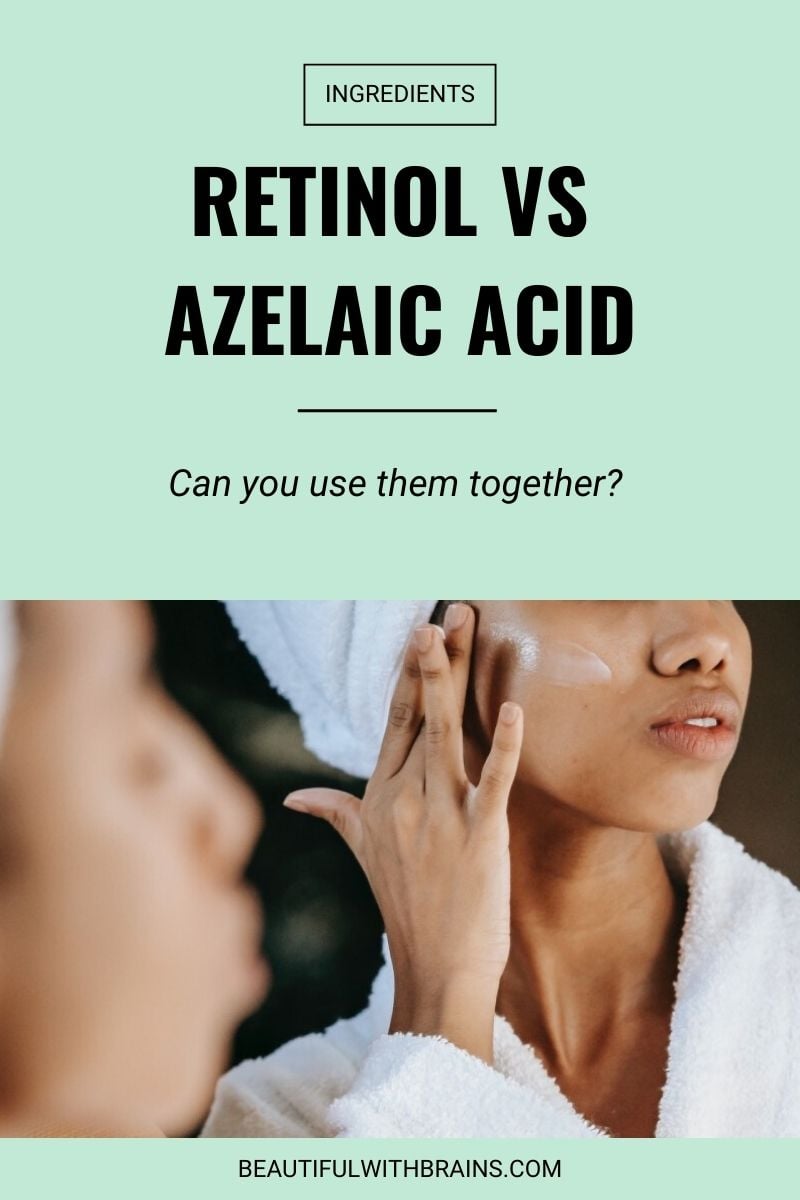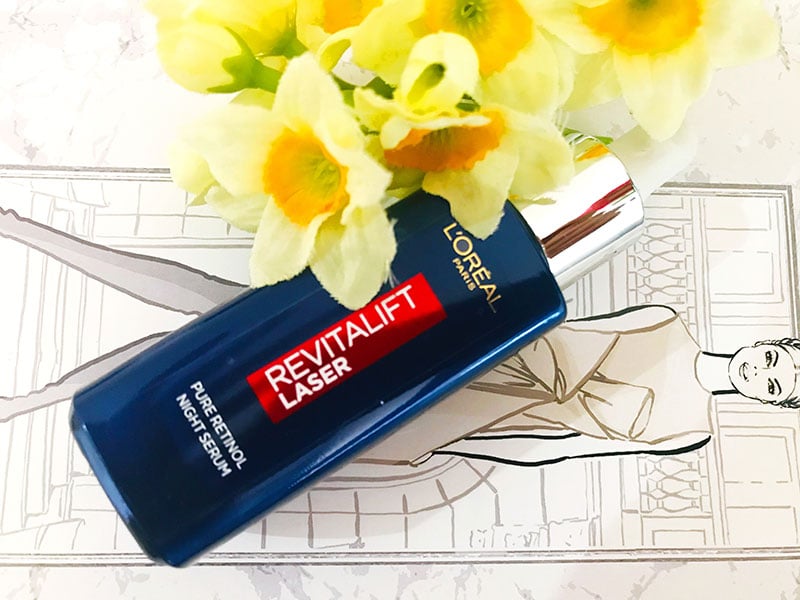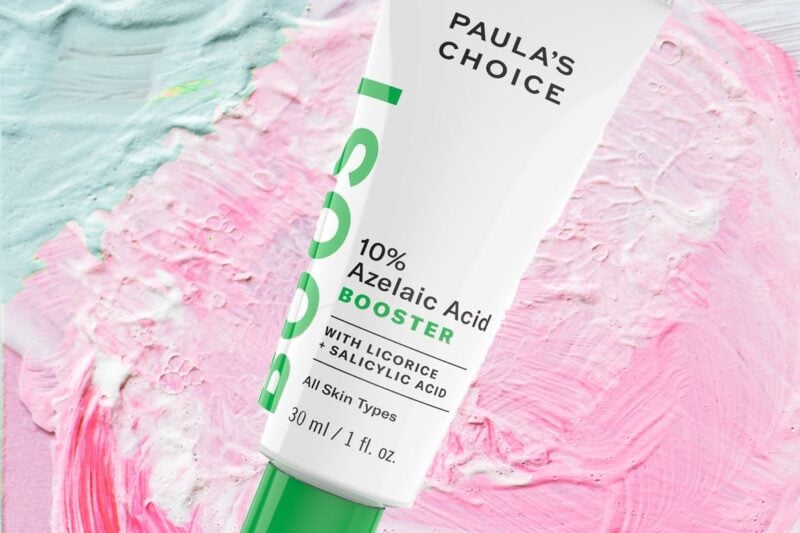
Can you use retinol and Azelaic Acid together?
Retinol and Azelaic Acid are two skincare superheroes with the same job description: they help you fight acne AND fade away hyperpigmentation. Yep, the best skincare ingredients are multi-taskers that tackle more than one concern.
If your face is covered in pimples and/or dark spots, should you use retinol or Azelaic acid? Or can you use retinol and azelaic acid together safely? Let’s find out what the science says:
- What Is Retinol And What Does It Do?
- What Is Azelaic Acid And What Does It Do?
- Retinol VS Azelaic Acid: What’s The Difference?
- Retinol VS Azelaic Acid: Do They Cause Acne?
- Who Should Use Retinol?
- Who Should Use Azelaic Acid?
- Can You Use Retinol And Azelaic Acid Together?
- What Are The Side Effects Of Using Retinol And Azelaic Acid Together?
- How To Use Retinol And Azelaic Acid Together: Which One Goes First?
- Can You Mix Retinol With Azelaic Acid?
- The Bottom Line
What Is Retinol And What Does It Do?
Retinol is a form of Vitamin A available off the counter. It must be converted into Retinoid acid (Tretinoin) into the skin for it to work its anti-aging magic.
Vitamin A in all its forms (including retinol) is the only treatment that’s been proven to work to reduce wrinkles. Here’s what it does:
- It accelerates cellular turnover: It speeds up your skin’s natural exfoliating process by prompting skin cells to turn over and die quickly, so that new, healthy ones can take their place. Result? Softer and smoother skin.
- It boost collagen: Collagen is the protein that makes skin thicker and firmer. Retinol prevents its breakdown and loss, keeping your skin firmer and younger-looking for longer.
- It has antioxidant properties: It fight free radicals, the rascals that cause premature wrinkles and dark spots.
- Treats acne: By speeding up cellular turnover, it helps dead skin cells fall off your skin. This matters because, when dead cells accumulate onto your skin too much, they end up falling into your pores and clogging them up. Next thing you know, you’re breaking out like crazy. Because of its exfoliating action, retinol helps get rid of whiteheads and clogged pores.
Or, said more simply, retinol:
- Reduces wrinkles (not just their appearance)
- Fades away dark spots and hyperpigmentation
- Brightens the complexion
- Makes large pores look smaller
- Firms and thickens skin
- Helps treat acne
Related: The Complete Guide To Retinol: What It Is, What It Does, And How To Use It
Don’t know which skincare products you can mix and match together and which ones deactivate each other? Download your FREE “How To Layer Actives Like A Pro” cheat sheet to get the most out of your skincare products:
What Is Azelaic Acid And What Does It Do?
Did you know Azelaic acid is made by the healthy bacteria that live on your skin? How cool is that? This multitasker helps treat acne, hyperpigmentation, and even rosacea. Here are just a few of its benefits:
- It has anti-bacterial properties that reduces P.Acne (the bacteria responsible for acne).
- It reduces inflammation, helping to heal both acne and rosacea. Plus, it reduces the redness that always comes along with acne.
- It improves the texture of your skin by reducing roughness and bumps.
- It reduces dark spots and hyperpigmentation by inhibiting the synthesis of melanin (the pigment that gives skin its natural colour). When the extra production of melanin halts, your skin goes back to its beautiful, natural colour.
- It also has a gentle exfoliating effect, helping to get rid of dead skin cells that would otherwise get caught up into your pores and give you breakouts.
Related: The Complete Guide To Azelaic Acid In Skincare

Retinol VS Azelaic Acid: What’s The Difference?
Both retinol and azelaic acid can treat acne and dark spots, but there are three key differences between the two:
- Mode Of Action: Azelaic acid exfoliates skin and pores, getting rid of dead skin cells. It just… doesn’t do it very well. It’s weaker than other acids, like Glycolic and Salicylic. Retinol speeds up cellular turnover, i.e. the skin’s natural exfoliating process. It doesn’t remove dead cells, but encourages skin to shed them faster. It may be a small difference, but it matters.
- Irritation: Retinol is very irritating. When you first start using it, it can cause dryness, irritation, redness, and peeling. Azelaic acid, on the other hand, is gentler and, usually, well tolerated even by people with sensitive skin.
- Anti-Aging: Retinol is an anti-aging superstar that can (in the long run – nothing works overnight when it comes to anti-aging!) reduce wrinkles and prevent new ones from forming. Azelaic Acid will make your skin look younger by tackling acne and dark spots, but it’s not as powerful when it comes to fighting wrinkles.
Retinol VS Azelaic Acid: Do They Cause Acne?
Retinol and Azelaic Acid are NOT comedogenic. They don’t cause acne breakouts. But, they may cause purging. What’s the difference?
On the surface, breakouts and purging can look the same: red, angry pimples that raise their ugly heads on their skin. In reality, there’s a key difference between a breakout and a purge.
A breakout happens when skincare ingredients get stuck in your pores, where they mix with dead skin cells and excess sebum. This mixture clogs up your pores. Enter P.Acnes, the bacteria that causes acne. It starts feeding on that mixture of sebum, dead cells, and other impurities (it’s literally its fave food). Next thing you know, you get a pimple.
A purge doesn’t cause new pimples from forming. It simply brings to the surface the pimples that were there already. Those nasty pimples don’t form in a day. They form deep into your pores before they rear their ugly heads on the surface. By exfoliating your skin and remove those top layers, you bring the pimples that were already forming underneath to the surface sooner. They’d have made an appearance anyway, but now you have the chance to deal with them sooner – and get clear skin sooner.
The other difference? As long as you keep using comedogenic ingredients, you’ll keep breaking out. Period. Purges last between 4 to 6 weeks. Your skin is worse off for the short term as all the impurities are brought to the surface. But once you’ve dealt with them, you get your clear skin back.
The best way to speed up a purge so your face doesn’t look like a battlefield for too long? Keep using retinol or azelaic acid. This is simply a sign they’re doing their job.
Who Should Use Retinol?
Retinol is the best wrinkle fighter available OTC. If you want to tackle wrinkles as well as acne and/or hyperpigmentation (or all three of them) AND your skin isn’t sensitive, retinol is the way to go. There’s a reason why it’s so hyped up. It just works.
Best Picks:
- The Ordinary Granactive Retinoid 2% Emulsion (£8.00): This simple formula contains both retinol and granactive retinoid, a new form of retinoid that’s great at treating acne. Available at Beauty Bay, Cult Beauty and Feel Unique
- Paula’s Choice Resist 1% Retinol Booster ($52.00): A high dose retinol serum infused with antioxidants to help you fight premature aging. You can use it on its own for maximum effect. If that’s too irritating for your skin, mix a couple of drops with your moisturiser. Available at Feel Unique and Paula’s Choice
- Paula’s Choice Super Antioxidant Concentrate Serum With Retinol ($34.00): This serum has a tiny dose of retinol that’s suitable for beginners. Plus, it’s infused with any antioxidants you can think of. Available at Paula’s Choice
Who Should Use Azelaic Acid?
If you’re dealing with acne or dark spots AND you have sensitive skin that can’t tolerate retinol, then Azelaic acid is the best option for you. It does the job without irritating your skin.
I know, I know, it’s not as good to treat wrinkles BUT retinol has side effects. You’re not going to look younger if your skin is all red, inflamed, and peeling from the retinol. Plus, retinol can dry out your skin, making the wrinkles you already have look worse. Do your sensitive skin a favour, and stick to Azelaic Acid and a good moisturiser.
Best Picks:
- Facetheory Lumizela A15 Serum (£24.99): This azelaic acid serum is enriched with skin-soothers like green tea and oatmeal to reduce dark spots, redness, rosacea, and irritations. Available at Facetheory
- Paula’s Choice 10% Azelaic Acid Booster ($36.00): This booster contains both azelaic acid and salicylic acid, an oil-soluble exfoliant that can get inside your pores and unclog them from within. Great at treating acne, you can use it on its own or mix it with your moisturiser. Available at Dermstore and Paula’s Choice
- The Ordinary Azelaic Acid Suspension 10% (£5.50): This serum has a thick texture that’s not the most pleasant to use. But if you’re on a strict budget and want to try azelaic acid, it’ll do the anti-acne and skin-brightening jobs. Available at Asos, Beauty Bay, Cult Beauty and Feel Unique
Can You Use Retinol And Azelaic Acid Together?
Still undecided? If your skin isn’t sensitive and can take the extra load, you can use retinol and Azelaic acid together.
This works especially well for hyperpigmentation, like dark spots, melasma, and post-inflammatory hyperpigmentation (the dark spots left behind by pimples).
Azelaic acid inhibits the activity of the tyrosinase enzyme, which is essential for the production of melanin (the pigment that gives skin its natural colour). Stop it from overacting and you stop the overproduction of excessive pigment.
Retinol, on this other hand, fades away dark spots by speeding up cellular turnover, i.e. the skin’s natural exfoliating process. In other words, it helps skin renew itself faster so that the older, darker cells on its surface give way to the newer and brighter cells underneath.
Use retinol and Azelaic acid together and you tackle dark spots on two fronts. Studies show retinol and azelaic acid are both effective when used alone, but work even better when paired together!
There’s also some research that shows that azelaic acid boosts the anti-acne effects of retinol. If you have severe acne, pairing these two actives together can help you heal faster.
One more thing: retinol and azelaic acid work at a similar pH. Retinol is most effective at a pH of 5.6 and azelaic acid at a pH of 4.0-5.0. There’s room for common ground to make both ingredients work well at treating acne and dark spots.
What Are The Side Effects Of Using Retinol And Azelaic Acid Together?
Retinol is a powerful ingredient that can cause dryness, irritation, redness, and peeling when you first start using it. Azelaic acid is better tolerated even by sensitive skin and doesn’t usually cause severe side effects.
Having said that, everyone’s skin is different. As always, when reading studies about combing ingredients together, you need to take these results into context. If you have severe acne and sensitive skin, the combination of retinol + Azelaic Acid will help you heal faster. It may cause some irritation, but the trade off is worth it. Of course, remember to moisturise well afterwards to counteract dryness and irritation.
BUT, if your acne isn’t as severe, then don’t be tempted to go overboard. Irritating your skin to get faster results is NOT a good idea and will only set your recovery journey back.
Related: All The Stages Of Acne: Causes And Treatments

How To Use Retinol And Azelaic Acid Together: Which One Goes First?
The best way to use retinol and Azelaic acid together is to get a product that has both, like VI Derm Retinol Age-Defying Moisturizer ($104.00).
If that’s out of your budget, the next best option is to layer two products, one with retinol, and one with Azelaic acid. For best results, apply the one with the thinnest consistency first. If both have the same consistency, then the order doesn’t matter.
Still, when you’re starting out, I recommend you introduce them one at a time. Use retinol for one month and then introduce azelaic acid (or vice versa). In case of an adverse reaction, this’ll help you determine who the culprit is. Plus, it gives your skin time to get used to these ingredients.
If using them together is too much for you, you can always alternate them at night. Never use retinol in the morning. It makes your skin more prone to sun damage!
Related: How To Layer Skincare Ingredients Like A Pro
Can You Mix Retinol With Azelaic Acid?
Have you noticed that when I told you that you can use retinol and azelaic acid together, I told them to opt for a product that has both or layer/alternate two different products? At no point did I tell you you can mix retinol and azelaic acid together.
I’m NOT a fan of mixing harsh actives together. Good skincare products are formulated for maximum efficacy. When you mix retinol and azelaic acid together, you could create a mixture that’s too harsh for skin. Or one of the products could include an ingredient or have a pH that makes the other active less effective.
For this reason, even if, in theory, you can mix retinol and azelaic acid together, I don’t recommend you do so in practice. It’s just not the best way to get the most benefits out of them.
The Bottom Line
You can totally use retinol and Azelaic acid together to tackle acne and hyperpigmentation – IF your skin isn’t sensitive and can take the extra load. If it gets irritated easily, then opt for Azelaic acid. It’s the gentlest of the two.

